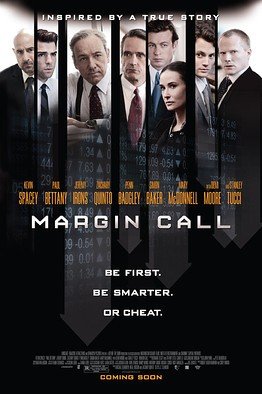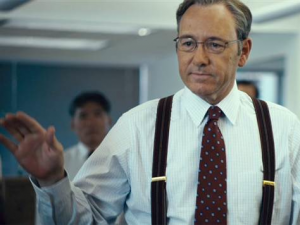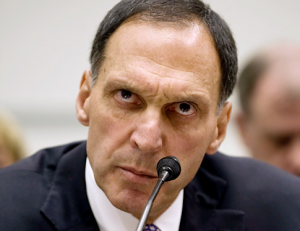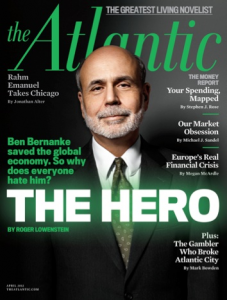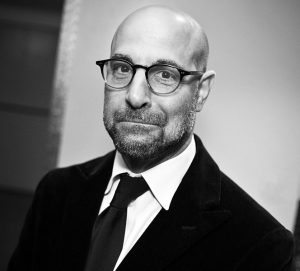How They Lie to Us: the film Margin Call
Edmund Connelly
Paul Craig Roberts made an intriguing reference the other day. He wrote that “a noted philosopher wrote an article in which he suggested that Americans live in an artificial or virtual reality. Another noted philosopher said that he thought there was a 25% chance that the philosopher was right. I am convinced that he is right. Americans live in the Matrix. Nothing that they know or think that they know is correct.” I agree.
The media, of course, is a constituent part of that Matrix, and I am particularly interested in the Hollywood branch of the media. Needless to say, most TOO readers are probably aware of Hollywood’s pronounced anti-White, anti-Christian bias and are clued in to the ways they subvert traditional White Christian culture.
One of my favorite essays unpacking Hollywood’s subversion has always been Kevin Beary’s “Adorno’s Bastards: Pleasantville and the Frankfurt School,” which parses the storyline of the anti-White film Pleasantville. Unfortunately, Beary’s colorful site with film stills has disappeared, leaving only this truncated version on another site.
Readers know I have done readings of many films and may also know that I’ve written quite a bit about Jewish involvement in finance and deception in that field (see here, here, and here). Today I’d like to write a review of a movie that encompasses both.
J.C. Chandor’s 2011 film Margin Call tells a story that loosely mirrors the fall of Wall Street giant Lehman Brothers. Even for Hollywood, however, the deception in this movie is staggering, and it occurs on many levels. It terrifies me to think that the masses will swallow this tale, particularly the images that will have such a powerful subliminal impact.
Now picture this: The Margin Call premise is that a group of WASPs and a Catholic or two run a leading investment bank on Wall Street. Things turn sour, however, and the firm is looking at bankruptcy unless they can pull off a miracle.
Obviously, such a scenario makes little real-world sense. In the real world, Wall Street is heavily Jewish, especially the investment banks. This is so obvious that Wiki has a special segment called Jewish investment banks, which includes, in part:
Jewish banking houses were instrumental to the process of capital formation in the United States in the late 19th and early 20th century. Modern banking in Europe and the United States was influenced by Jewish financiers, such as theRothschild family and Warburg family, and Jews were major contributors to the establishment of important investment banks on Wall Street.In the middle of the nineteenth century, a number of German Jews founded investment banking firms which later became mainstays of the industry. Most prominent Jewish banks in the United States were investment banks, rather than commercial banks. … In many cases, the efforts of Jewish immigrants to start banks was enabled due to the substantial support of their Jewish banking connections in Europe.Several major banks were started following the mid-1800s by Jews, includingGoldman Sachs (founded by Samuel Sachs and Marcus Goldman), Kuhn Loeb(Solomon Loeb and Jacob H. Schiff), Lehman Brothers (Henry Lehman),Salomon Brothers, and Bache & Co. (founded by Jules Bache).
So Lehman Brothers was a classic Jewish investment bank. For those wishing to find more explicit discussion about the Jewish origins and uninterrupted Jewish roots of Lehman Brothers, see the following: Stephen Birmingham, Our Crowd: The Great Jewish Families of New York (New York: Harper and Row, 1967) andThe Rest of Us: The Rise of America’s Eastern European Jews, (Boston: Little, Brown & Company, 1984); Jean Baer, The Self-Chosen: “Our Crowd” is Dead — Long Live Our Crowd (New York: Arbor House, 1982); Richard L. Zweigenhaft and G. William Domhoff, Jews in the Protestant Establishment (New York: Praeger Publishers, 1982); and Gerald Krefetz, Jews and Money: The Myths and the Reality(New Haven and New York: Ticknor and Fields, 1982).
Priceless in this respect is Judith Ramsey Ehrlich and Barry J. Rehfeld’s The New Crowd: The Changing of the Jewish Guard on Wall Street (New York: HarperPerennial, 1989); they personally interviewed many of the Jewish participants under discussion here. They also fill out background on Lehman partners and traders, contrasting, for example, “Our Crowd” Bobbie Lehman with the coarse and brash Lewis Glucksman. Typically, they write of Lehman Brothers:
Chairman Frederick Ehrman and president Warren Hellman, who was Ehrman’s nephew, were the very soul of Our Crowd’s Jewish banking aristocracy. The Hellmans had built the Wells Fargo bank in San Francisco into one of the most post powerful financial institutions in the country. They were related by marriage to the Seligmans, the most important Our Crowd family in New York during the nineteenth century.
To drive home how common it is to have Jewish executives in these investment firms, note that Ehrlich and Rehfeld write that “Without consulting anyone,” Glucksman as chief executive of Lehman “appointed as president of the firm his closest ally, Robert S. Rubin.” That is a different banker from former Secretary of the Treasury, Goldman Sachs co-chairman, and later Chairman of Citibank Robert E. Rubin.
The last CEO of Lehman Brothers, from 1994–2008 was Richard Fuld, born to Jewish parents in New York City. When, at a Congressional committee hearing, fellow Jew Rep. Henry Waxman said to Fuld, “Your company is now bankrupt, our economy is in crisis, but you get to keep $480 million,” Fuld corrected him by saying it was only $300 million.
Ehrlich and Rehfeld conclude that these Jewish “New Crowd” bankers “challenged the dominance of the old corporate culture, overturned the traditional rigid management hierarchy . . . [and in] the process, the New Crowd broke the stranglehold of the Establishment Wasp bankers.” Note that when WASPs dominate an industry, the word ‘stranglehold’ is used. However, to say that Jews have a “stranglehold” on investment banking or on Hollywood would be deemed anti-Semitic.
In Margin Call, these facts are everywhere hidden, beginning with the head of the trading floor, Sam Rogers (Kevin Spacey). Spacey looks, acts and talks exactly like the middle-class White man he played in American Beauty. In Margin Callthere is not even an attempt to give him a Brooklyn accent or exaggerated mannerisms. Or to have him wearing a kippah as he did for his role as Jack Abramoff in Casino Jack.
Further, out on the trading floor we see two young traders, Peter Sullivan (Zachary Quinto) and Seth Bregman (Penn Badgley). At least these young men have dark hair.
In contrast, trading desk head Will Emerson (Paul Bettany) is dirty blond with blue eyes.
More amazing still, we find that Sam Rogers, boss has a Jewish name (Jared Cohen) but is played by blond, blue-eyed actor Simon Baker.
Most egregiously, however, is the fact that the part of Lehman Bros. CEO is played by none other than the arch-British-Aryan actor Jeremy Irons.
Tellingly, Irons’ character is given the name “James Tuld,” which, as a Wall Street Journal article, quoting the filmmakers, tells us “is a hybrid of Merrill Lynch’s ex-CEO John Thain [who is not Jewish] and Lehman Brothers’ ex-CEO Dick Fuld.” Perhaps bringing in Thain is another way of defusing the Jewish angle. I mean, why not have the character be a cross between Richard Fuld and Lloyd Blankfein? Or Richard Fuld and Robert E. Rubin?
Next, let’s consider the plot of the film. As in real life back in 2008, the market is falling fast and the investment firm in the movie is feeling the pain. Staff is let go, and the survivors anxiously mill about the office. As I will explain later, trader Peter Sullivan, working late, discovers that the firm’s exposure is potentially greater than the entire value of the firm, meaning bankruptcy if the market goes not improve markedly. And there is little hope of the market improving.
The alarm goes up the chain of command and eventually CEO Tuld helicopters in for a power meeting. Upper class, he is rather casual and composed given the predicament his firm is in. But we quickly realize that he’s led a blessed existence, one where things come to him without effort. As he comments when addressing the assembled staff, “It wasn’t brains that got me here.” White male privilege, I suppose. Surely he’s not implying that Jewish connections have anything to do with it.
Though Tuld does think and act in a way that could be termed immoral, Irons’ playing of the role renders his attitude as less threatening, tinged very slightly with a wry, detached view of the whole situation. A product of privilege, Tuld can casually say that it’s only paper money they’re talking about. He’s simply taking an upper-class position where the impact of his decisions on his subordinates does not enter into his thinking.
Sam Rogers, on the other hand, is the moral center of the film, shown in part by his weeping over the cancer diagnosis his dog has just received. As the firm’s crisis intensifies, he is the most troubled by the moral implications of the actions the firm will likely take. And those actions, as dictated by Fuld, entail the deceitful liquidation of all the toxic assets on the firm’s books. Hundreds of millions of dollars of junk knowingly peddled to client’s who (in general) trust the firm. For Tuld, it is just part of a game of musical chairs where someone will be left standing when the music stops. He aims to act first and secure a coveted chair.
Rogers initially opposes this course, telling his boss “You’re selling something you know has no value.” Unperturbed, Tuld replies with resignation, “The numbers, they just don’t add up anymore.” A natural-born manipulator, Tuld puts in motion his plan to save the firm, and begins by selecting someone to take the fall. That person is chief risk management officer Sarah Robertson (Demi Moore). In the scene where Tuld persuades Robertson to take the fall, Irons’ acting is superb, as he is both reassuringly friendly yet implacable. Scenes like this confirm my suspicion that the truly great actors are always British.
The climax of the film comes when Rogers must make a choice: follow his conscience or save the firm (and earn himself a lot of money in the process). He chooses to save the firm, which means deceiving his sales staff (who really aren’t that clueless) and his buyers. Calls are made and heavy discounts given. The worthless assets are now someone else’s problem.
Crushed at his own lack of moral fiber, Rogers confronts Tuld as the latter nonchalantly eats his meal alone in the executive dining room high over Manhattan. Rogers is furious, boiling over with a mix of emotions, while Tuld could be a diner merely contemplating how to spend an upcoming weekend. Rogers hurls bitter accusations at Tuld, but Tuld, tucking into his food, simply states, “I’m starting to feel a little better about this thing.” After all, his millions are safe again.
Returning to my original thesis that Margin Call is meant as deliberate deception concerning who, exactly, is to blame for the perilous financial crisis beginning in the fall of 2008, we now encounter the most blatant message-implanting of the entire movie: the early firing of a dedicated employee.
The action begins with the entrance of a team of consultants hired to fire a long list of employees. Composed of three White women and one black man, my initial reaction was to groan that this was another Hollywood attempt at visual social engineering, but it turns out that they’re the bad guys. The scene reminded me of George Clooney’s 2009 movie Up in the Air, where he plays a consultant whose job is to lay people off for heartless executives who are too chicken to do it themselves. There, though, Clooney was fairly charming, but the woman who fires risk manager Eric Dale is seriously creepy, over-enunciating every word as she blinklessly explains her mission. If I were a blade runner, I would assuredly terminate her under suspicion of being a replicant.
Eric Dale has a powerful position, but he appears as a genuinely nice guy. Family photos cover his desk, and he speaks politely. He looks like the “heroic” Federal Reserve Chairman Ben Shalom Bernanke:
Here’s the Eric Dale character:
In a movie about a Wall Street investment firm, I certainly thought the character looked Jewish. To be sure, Stanley Tucci, the actor, is Italian American, but what counts is his screen role, and he easily passes as Jewish in that Wall Street setting. And what does the movie say about him? It says that he is a victim of the greedy and hard-hearted White people around him. Through no fault of his own, he is evicted from his office and his career comes to an end with his meager possessions in a few boxes. Ever conscientious, however, he even gives Peter Sullivan, one of his subordinates, a memory stick containing the information about the toxic assets on the firm’s books. That information, as we saw, allows the firm to survive. Dale is later seen returning to the firm after they have begged him for his expertise; he complies.
One more comment about the plot. As noted, Sam Rogers is the moral center of the film. He wants to be honest, but decades on Wall Street have also toughened him. The dying dog is introduced to show in a fleeting moment his soft inner core. In the last scene of the film, after Rogers has sold out his clients, we see him burying his dead dog in his ex-wife’s yard (too many hours spent at the office?). His integrity has died. This conceit did not work for me and was probably not the best possible way to end the film.
In my readings of Hollywood films, I tend to implicitly or explicitly rely on the auteur theory. Wiki gives us a good enough account of that theory here:
In film criticism, auteur theory holds that a director’s film reflects the director’s personal creative vision, as if [the director is] the primary “auteur” (the French word for “author”). In spite of—and sometimes even because the production of the film is part of an industrial process, the auteur’s creative voice is distinct enough to shine through all kinds of studio interference and through the collective process.In law, the film is treated as a work of art, and the auteur, as the creator of the film, is the original copyright holder. Under European Union law, the film director is considered the author or one of the authors of a film, largely as a result of the influence of auteur theory
To unpack the propaganda message of Margin Call, however, I cannot rely upon this theory because writer and director J.C. Chandor appears not to be Jewish. If it were Joel Schumacher or Oliver Stone, I’d have an obvious answer. And of course if Steven Spielberg were involved at any level, it would be a no-brainer. But Chandor created this movie, so we need to consider the casting and visual implications of the film in another way.
Frankly, I think this is easy. Anyone wishing to succeed in Hollywood learns about the reigning assumptions and taboos, and honors them, particularly if they’re a young outsider like Chandor. Those who violate the norms get punished (Marlon Brando, but especially Mel Gibson, come to mind). And the hegemonic power that controls Hollywood — that is Hollywood — is Jewish. Neal Gabler demonstrated this in his book An Empire of Their Own: How the Jews Invented Hollywood, and Joel Stein said so in the LATimes (“How Jewish is Hollywood?”). I too made it beyond argument in my Occidental Quarterly essay “Understanding Hollywood Part I: Hollywood’s Jewish Identity,” where I concluded that “Hollywood is indeed run by Jews.”
Just as few films ever show the vast power held by Hollywood Jews, few films ever show the vaster power held by Jews on Wall Street (and, I may add, in Washington). Chandor could have made a film that explicitly reflected the Jewish contingent at Lehman Bros., but you can be sure that if he had, it never would have been released. And he would be looking for another line of work.
